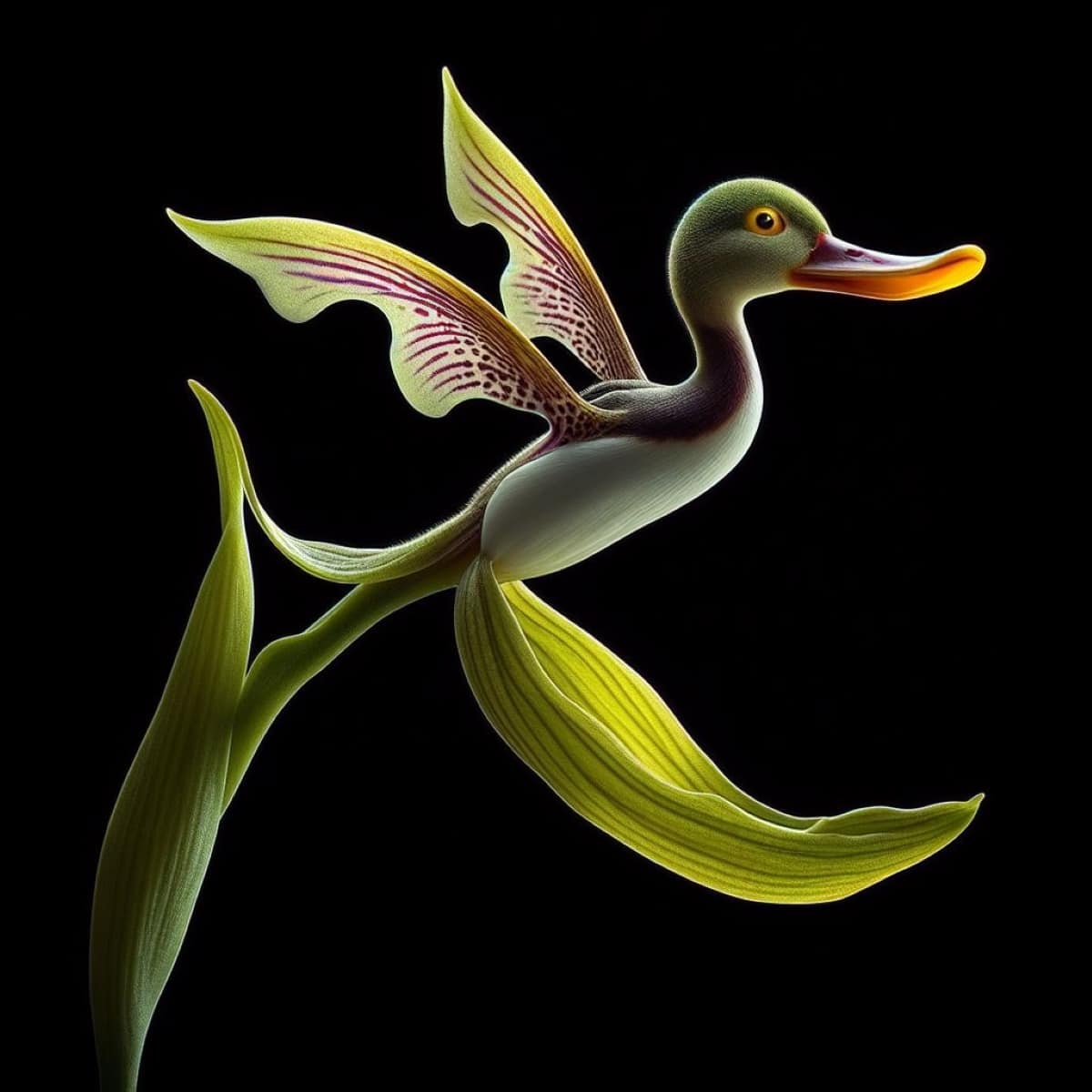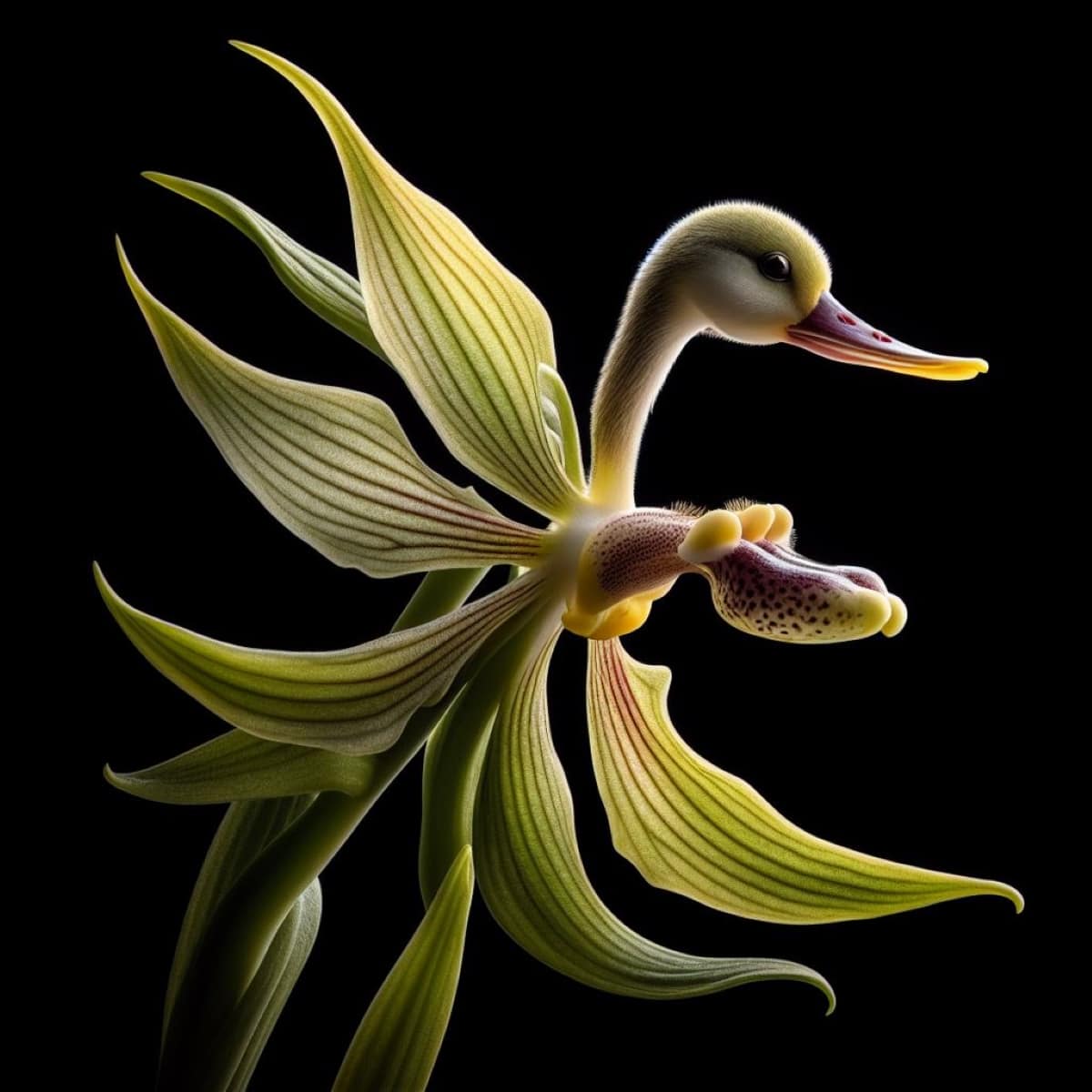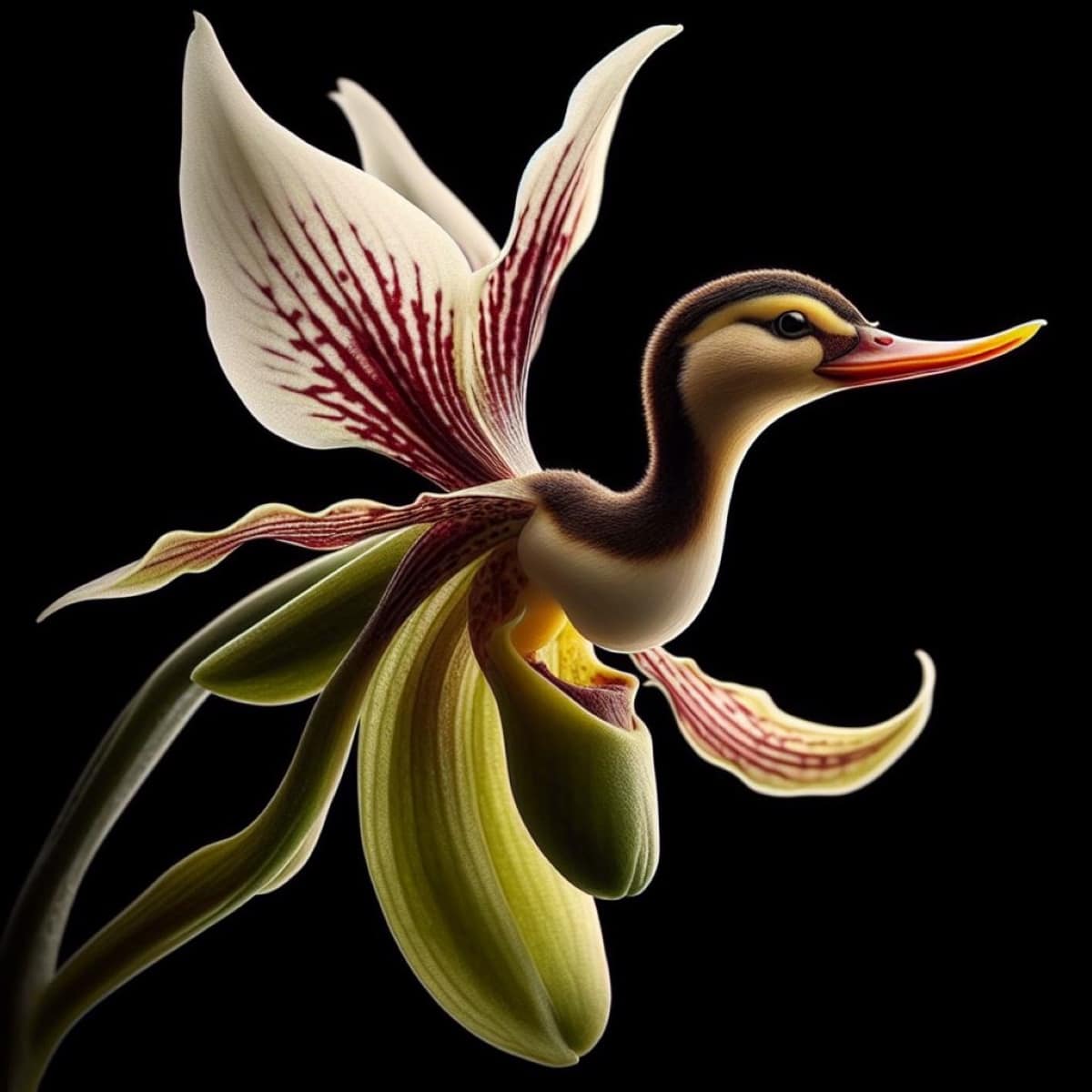The Flying Duck Orchid, scientifically known as Caleana major, is an extraordinary orchid species native to Australia. Renowned for its distinct and whimsical flower resembling a flying duck, it captivates enthusiasts and researchers alike with its unique charm. The orchid’s captivating appearance and intricate features make it a fascinating subject of study and admiration in the realm of botany. Here’s a comprehensive overview covering various aspects from its life cycle to cultivation.

Flying Duck Orchid
Habitat and Distribution of the Flying Duck Orchid
The Flying Duck Orchid (Caleana major) is a fascinating and distinctive orchid species native to Australia. Typically, these are found in the southern and eastern parts of the country, and they thrive in heathlands, woodlands, and coastal scrub environments. This remarkable orchid earned its name due to the flower’s resemblance to a flying duck in mid-flight.
The plant’s unique adaptation includes a specialized pollination strategy, attracting male sawflies with its duck-shaped labellum. Its distribution spans across various states, including Victoria, New South Wales, and South Australia. This charismatic orchid’s habitat preferences reflect its ability to adapt to diverse Australian ecosystems, captivating botanists and nature enthusiasts alike.
Physical Characteristics of the Flying Duck Orchid
- The Flying Duck Orchid (Caleana major) flower resembles a small duck in flight, with a prominent, downward-curving lip mimicking the duck’s bill.
- The plant typically reaches a height of 20-40 cm, featuring a single leaf and a reddish-brown coloration.
- The intricate mimicry serves a functional purpose, attracting male sawflies that mistake the flower for a female insect.
- As the insect attempts to mate with the flower, it inadvertently assists in pollination.
- This remarkable adaptation showcases nature’s creativity in orchestrating symbiotic relationships for reproductive success.
Life Cycle and Reproduction of the Flying Duck Orchid
The life cycle of the Flying Duck Orchid encompasses various stages, from seed germination to flowering. This orchid employs a specialized reproductive strategy, relying on specific fungi for germination. Once mature, the plant produces a single flower that entices male sawflies by mimicking the appearance and scent of a female insect.
As the deceived sawflies attempt copulation, they inadvertently facilitate pollination. The orchid’s reliance on this intricate process highlights the complexity and adaptability of its reproductive mechanisms, contributing to the enduring allure of the Flying Duck Orchid in botanical circles.
Ecological Importance of the Flying Duck Orchid
The Flying Duck Orchid (Caleana major) holds ecological significance as a unique and captivating Australian native species. Its intricate flower, resembling a duck in flight, plays a crucial role in pollination. The orchid attracts male sawflies with its mimicry, utilizing them as unwitting pollinators.
In case you missed it: How to Grow Orchids Hydroponically: Can Orchids Grow in Water?

This symbiotic relationship contributes to the orchid’s reproductive success and genetic diversity. As a part of the delicate balance within its ecosystem, the Flying Duck Orchid underscores the interconnectedness of flora and fauna. Its presence adds to the biodiversity of native landscapes, emphasizing the importance of preserving these intricate relationships for the overall health of ecosystems.
Cultural Significance and Uses of the Flying Duck Orchid
The Flying Duck Orchid (Caleana major) holds cultural significance as a distinctive Australian native orchid. Revered for its unique flower resembling a duck in flight, it captivates indigenous communities, symbolizing nature’s creativity and the interconnectedness of flora and fauna. Its mesmerizing appearance has also garnered attention in popular culture, serving as an emblem of Australia’s diverse and extraordinary plant life. Beyond aesthetics, the orchid plays a crucial role in ecosystems, contributing to biodiversity and ecological balance.
Conservation Status and Threats to the Flying Duck Orchid
These orchids, in general, often face threats such as habitat loss due to urbanization, agriculture, and deforestation. Additionally, the illegal collection and trade of rare and endangered orchids can pose a significant threat to their survival. Climate change, invasive species, and changes in land use patterns can also impact orchid populations.
Apart from the potential danger of experiencing loss due to significant changes in its habitat, this orchid faces threats from both insect and wallaby browsing, as well as the constant peril of removal by plant collectors. The preservation efforts for this species currently rely on the diligent management of a singular individual who safeguards it against these hazards. Australia boasts a thriving population of the Flying Duck Orchid.
Interesting Facts and Myths About the Flying Duck Orchid
Facts
- Mimicry Mastery: The orchid’s flower closely resembles a flying duck in flight, complete with a beak and wings, to attract male sawflies.
- Pollination Strategy: Male sawflies are lured by the flower’s appearance and attempt to mate with it, inadvertently facilitating pollination.
- Limited Distribution: Found primarily in the southern and eastern parts of Australia, the orchid is selective about its habitat, favoring well-drained soils.
- Tiny Flowers: Despite its elaborate appearance, the actual flower is relatively small, measuring only about 1.5 centimeters.
Myths
- Actual Flight: Contrary to its name, the Flying Duck Orchid does not possess any ability to fly. Its name originates from its distinctive visual resemblance.
- Duck Connection: While the flower does bear a resemblance to a duck in flight, it’s a result of natural selection and adaptation, not a direct connection to ducks.
- Sawfly Mating: The myth that sawflies mistake the orchid for a potential mate is true, but it’s a natural process, not a deliberate strategy employed by the orchid.
In case you missed it: Flower Seed Germination Chart: Timeframes and Requirements

Comparison with Other Orchid Species
In comparison to other orchid species, the Flying Duck Orchid stands out for its extraordinary floral adaptation, utilizing deception to ensure pollination. Unlike many orchids that rely on bright colors and enticing fragrances to attract pollinators, the Flying Duck Orchid employs visual mimicry as its primary strategy. While some orchids exhibit intricate symbiotic relationships with specific pollinators, the Flying Duck Orchid’s reliance on deceit sets it apart.
This species showcases the versatility of orchids in evolving diverse pollination mechanisms to survive in various ecological niches. Despite its unique characteristics, the Flying Duck Orchid shares common features with other orchids, such as the intricate structure of its reproductive organs. This underscores the underlying unity within the Orchidaceae family, where each species has adapted in its distinct way to ensure reproductive success in its specific environment.
Cultivation and Care Tips for the Flying Duck Orchid
- Light: Provide bright, indirect light for the Flying Duck Orchid (Caleana major). Place it near a window with filtered sunlight or under fluorescent lights.
- Temperature: Maintain a temperature range of 15-24°C during the day and a slight drop at night. Avoid extreme temperature fluctuations.
- Humidity: Keep humidity levels around 50-70%. Place a tray of water or use a humidifier to achieve the required moisture.
- Watering: Water the orchid when the top inch of the soil feels dry. Use lukewarm water and allow excess to drain. Overwatering can result in root rot; it should be avoided.
- Soil: Use a well-draining orchid mix with bark, perlite, and sphagnum moss. Repot every 1-2 years to refresh the medium and inspect the roots.
- Fertilization: Feed the orchid with a balanced orchid fertilizer during the active growing (spring and summer) every 2-4 weeks. Reduce or stop feeding in the fall and winter.
- Blooming: The distinctive “duck” flower may bloom in spring or summer. Mimic its natural environment with a winter rest period, reducing water and providing cooler temperatures to encourage blooming.
- Support: As the flower stem emerges, provide support with stakes to prevent bending or breaking.
- Pests and Diseases: Monitor for pests like aphids or spider mites. Treat with insecticidal soap if needed. Keep good air circulation to prevent fungal diseases.
- Rest Period: After blooming, reduce watering and allow the plant to dormant during the winter months. Resume regular care in spring.
- Observation: Watch for any signs of stress, like yellowing leaves or lack of growth, and adjust care accordingly.
- Propagation: While challenging, Flying Duck Orchids can be propagated through division or by sowing fresh seeds onto a suitable medium.
In case you missed it: Everything You Want to Know About Chrysanthemum Seed Germination

Conclusion
In summary, the Flying Duck Orchid is a captivating orchid species with a unique life cycle and appearance. Cultivating these orchids requires attention to their natural habitat conditions, and conservation efforts are crucial to preserving their existence in the wild.
Note: The images presented in this post are intended solely for representation purposes. The images are meant to serve as visual aids and should not be relied upon as accurate representations of their real-life counterparts.
- Feed Your Flock for Less: Top 10 Tips to Save on Chicken Feed
- Ultimate Guide to Ossabaw Island Hog: Breeding, Raising, Diet, and Care
- Hatching Answers: The Top 10 Reasons Your Chickens Aren’t Laying Eggs
- Eggs and Economics: Breaking Down the Cost of Raising Backyard Chickens
- Defend Your Greens: Proven Methods to Keep Iguanas Out of Your Garden
- Ultimate Guide to Cinnamon Queen Chicken: A Comprehensive Guide for Beginners
- Ultimate Guide to California Tan Chicken: Breeding, Raising, Diet, Egg-Production and Care
- Ultimate Guide to Marsh Daisy Chicken: Breeding, Raising, Diet, and Care
- 10 Types of Chicken Farming Businesses You Can Start for Profits